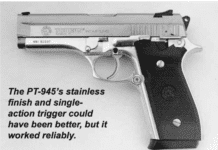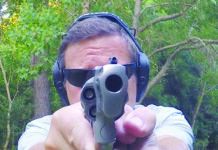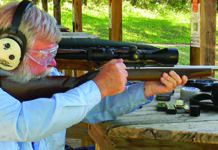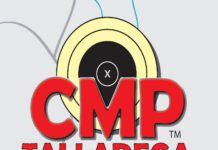Re “Affordable DefenseShotguns: Benelli, Stevens, CZCompete,” October 2013
I really enjoyed the article comparing the Benelli, Stevens, and CZ scatterguns; however, I’m still going to rate my Winchester Model 1300 Defender over all of them. It was half the cost of even your cheapest test gun, as I bought it for a C-note at a pawn shop, and the Winchester pump action is, if you’ll pardon the horrible pun, damn near bulletproof. Plus, there’s that unmistakable sound of racking a 12-gauge shell into the chamber that’s just about guaranteed to stop the heart of an intruder. Keep up the great work. I’ll certainly keep subscribing.— Dave Vick
We agree the Defender (shown above) is a fine firearm. In the September 2005 issue, we said of the Winchester Defender Model 1300 Pistol Grip & Stock Combo, No. 512907308, $354: “Our Pick. This combo offered the best mix of speed, capacity, and resistance to jamming, and this package also came with a pistol grip, which makes it a smaller, lighter payload than the other guns. If the Defender had a slightly larger action release button and came drilled and tapped for sights, it would become even more formidable.” — Todd Woodard
Re “Short 45 ACPs from Sig Sauer, Kimber, and SpringfieldArmory,” August 2010
Smith & Wesson has a CCO size 1911 on the website called an SW1911 Compact ES-Extended Slide. Any chance of you reviewing it? I wonder how it would stack up compared to the SIG and Kimber CCO-sized 1911’s you tested in the August 2010 issue. Also, do you know if this size 1911 (4.25-inch barrel and shorter grip) is as reliable as a Commander or full-size 1911? One other pistol I wonder about is a Colt 1991 series DAO I saw on their website under the 1991 series list. It would be interesting to read one of your reviews on that one. Thanks for a trustworthy, enjoyable and informative publication.
— Whitney Prentice
Good ideas. I’ve forwarded your note for development. As for reliability, that’s one of the things we test for. For those who are just joining us, the SIG Sauer 1911 C3 No. 19GS0031 45 ACP, $1200, got an A grade in that test conducted by Ray Ordorica. Summary: “We liked the combination of the Commander-length slide and Officer’s-model grip length of the Sig Sauer 1911 C3. The classy slim checkered-wood grips added to its handsome two-tone look. The external extractor never faltered, and the gun shot to its fixed sights. With a reasonable price for what you get, in our opinion, what’s not to like?
The Kimber Compact Stainless II 45 ACP, $1009, got an A-. Summary: “We liked the simple, clean lines and absence of non-essentials on the lightweight Kimber Compact Stainless II. The checkered rubber grips helped control the gun in recoil, but we would have liked checkering on the front strap. The fixed sights did not have tritium inserts, and some will want them. We liked the feel of the single-side safety as well. We didn’t like the takedown procedure, which requires a small bent pin, easily made from a paper clip if you lose both of those provided with the gun. Do you carry paper clips in the field?” — tw
Re “Outfitting Your Rifle: We Try Triggers, Stocks, and Magazines,” October 2013
We enjoyed reading your review of our triggers and noted that you had a problem with the Hi-Speed install. Since it is an adjustable trigger, the design necessitates a slight widening of the trigger body. This design will work with a standard Colt AR safety selector with a .330-inch trigger slot. We have recently been seeing an influx of safety selectors with a trigger slot width of .298-inch being used by some manufacturers. Our SSA and SD series of triggers will work with the smaller slot, but the Hi-Speed requires the slot to be opened up.
Although it doesn’t happen too often, we have found lower receivers with an undersized trigger well or hammer hole location too close to the radius of the well, causing a tight fit of the Geissele hammer. If anyone has any questions or encounters a problem during the install, they are able to call and speak to a tech who can answer their questions and determine what course of action needs to be taken. Should it require sending the lower and trigger in to our shop, we do a 24-hour turnaround, if possible, when we receive it. All of our triggers have a lifetime guarantee.
If you get a chance to go to the National Matches at Camp Perry during the summer, please stop by and speak to our salesperson or tech, who routinely installs and services between 30 to 50 new and old Geissele Hi-Speed triggers a day during CMP service rifle week. Please feel free to call and contact us if you have any questions or would like to learn more about our triggers and other products.
— John ButterworthProduction SupervisorGeissele AutomaticsNorristown, PA
We appreciate the follow up. I’m currently working with a Geissele NM model in an RRA Operator I’m fooling with. To say it’s a massive improvement over the stock trigger understates the quality. — tw
Re “Downrange,” November 2013
After reading your editorial, I am spurred on to purchase a suppressor. Ideally, one for a TTI 556/223 with a bull barrel and one for a Bushmaster Carbon 15 flattop 556/223, both of which currently have flash suppressors. Our CLEO has assured me he supports the signing of the CLEO Certificate and will do so. My question to you is: Can you provide me with the name of a dealer that will print out a trust (preferably free), and the ATF paperwork, scan it, and submit it for me electronically? Then allow me to pay for the tax stamp with my credit card, as your article suggested? Or, whatever it takes to complete the transaction.
FYI, I am a retired USN SEABEE, and Georgia Department of Corrections correctional officer. I am on my first year subscription to your magazine and truly look forward to each month’s edition.
— John Ludlum
I got my trust done free from James Hillin at Full Armor Firearms in Houston. Setting up the trust required the purchase of a serial-numbered product — which I can’t have until BATFE blesses it. Currently about 6 months. Contact them at (832) 486-9086. Our primary Houston testing facility, Tactical Firearms in Katy, Texas, (281) 693-4867, also handles trust paperwork as part of a purchase. Or contact Michele Byington at Texas Law Shield. She’s the Class 3 wizard at that law firm. Call them for fees at (877) 448-6839. — tw
Re “Rock River Arms,ArmaLite, and BushmasterCompete,” September 2013
I picked up this issue of Gun Tests while waiting for my wife at the doctor’s office and read your review of Bushmaster’s Carbon 15 Superlight AR-15. You gave it a “B” overall. In my experience, you failed to test it as thoroughly as should have been done because I owned one for a brief period of time and an “F” is giving it too much credit.
I was in the market for an AR. While visiting with my local FFL, he showed me the C15 in the Jerry’s Sporting Goods ad he had, told me he had a half-dozen guys curious about the rifle, but they were unwilling to pull the trigger, pun intended. I said, “What the hell” and told him to order one for me. Upon receipt, I was impressed with its light weight. Mine came with a Bushnell Trophy red-dot scope (1X), but I planned on using the rifle for close-range coyotes and predators. My hope was to find an entry-level AR style rifle that didn’t break the bank and cost $1k+. So, I mounted up a 3-9×40 Burris FFII that I had and went to the bench. I began by trying to get the rifle to POA=POI at 25 yards. No luck. I moved to 10 yards — point blank. At 15 yards, the rifle was producing 16-inch groups. Yeah, 16 inches!
I called Bushmaster and they sent me a shipping label. I packaged and returned the rifle with instructions that I didn’t need it back if it couldn’t be fixed to produce less than 1-inch groups at 25 yards. Three weeks later, I received the rifle back with a note that the barrel nut had not been properly torqued and indexed for the gas tube, that this had been done, and it included a range target that showed test rounds grouping about 2.5 inches at 25 yards. Subpar, IMO. I returned to the bench after remounting my Burris glass and still, at 40 yards, I could not get the rifle to group.
POI between the first and second round would be as much as 8 inches apart and there was no consistency as to where the flyers would appear. Since the rifle had just been completely checked out at the factory, I wondered if it was my scope. I began checking and rechecking the rings, base, and risers when I realized that the entire scope/base assembly was moving. In fact, there was ~1⁄8 inch lateral movement at the top turret on the scope.
Upon further examination, I discovered that the Picatinny rail was moving around on the dovetail that is cast as part of the composite upper. Quite a bit of movement, in fact. I surmised that this was due to the retention screw at the front end of the rail being improperly torqued. So, I removed the scope and tried to adjust that machined Allen screw, only to discover that the screw was threaded into threads that had been tapped into the composite material of the upper, and that the threads had completely warbled out. In fact, the screw lifted out of the hole with the Allen wrench and tiny slivers of composite material — heretofore those threads — fell to the surface of my work bench. I was shocked that they would design this sort of attachment and considered inserting a small nut into which the retention screw could be inserted, but you cannot do that because the screw bottoms out on top of the gas tube.
I then considered resetting the rail and screw using an industrial-strength epoxy that I use in my shop, but decided that 1) doing so would likely void my warranty, and 2) when you spend $700+ for a rifle, you shouldn’t have to cobble it together with duct tape and baling wire to make it usable. And, it was now unusable because, as you noted in your review, there is no alternative sighting system with this rifle. I was the owner of a $700 paper weight.
I recontacted Bushmaster, and they once again sent me a shipping label. Back to the factory. Five months later, having heard nothing about my rifle, I called, called and called. Finally, someone there told me they were replacing the barrel and would send it back as soon as that was done. I inquired about the time frame and was advised that they had no delivery date on barrels, so he didn’t have any idea. I asked about the issue concerning the rail attachment, and there was not a single note in the file in front of him about any such problem. Had I waited for my rifle, I would very likely have gotten it back with the same problem it went to them for, unrepaired, except that now I would have a new barrel to replace one that had nothing wrong with it and had been broken in.

I owned that gun for nine months and, for seven of those, it was either in the factory for rework or en route between there and me.
The problem arose because of the torsion that was created on that rail attachment point by the weight of a regular sized scope attached on top of risers on top of the rail, creating a fulcrum effect. Even if the designers did not intend this rifle to bear a conventional scope, there is no mention of this in the literature that accompanies the rifle. It’s a 223 Rem/5.56-caliber rifle and has an effective range of several hundred yards, which means that it is very possible that the purchaser might choose to equip this gun with something more potent than a featherweight 1X red-dot sight.
Your reviews are unbiased and objective, and I felt it important that you were at least aware of my gun’s history and flaws.— C.L.
C.L. is indeed correct. The top aluminum rail to which the scope is attached is held by a single tiny screw in front, and by a small dovetail in the bottom of the aluminum rail that slides over the plastic top of the receiver. Clamping the scope rings somewhat tightens the rail to the plastic, but would not be suitable for any scope with significant mass, because the whole thing would tend to fly forward on recoil, thus challenging that tiny screw. Perhaps Bushmaster could insert a threaded steel block to take the small screw. As it is, I would never buy this gun. C.L. is right: This is a horrid design.
— Ray Ordorica




























